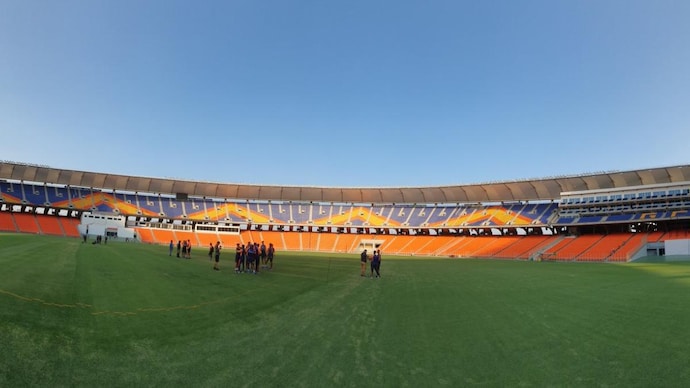Narendra Modi stadium seating capacity, boundary size, architecture, total cost, photos, video and location
Narendra Modi stadium, which was previously also known as the Motera stadium, was closed for renovation in 2015. It hosted its first international One Day match in 1984.

In Short
- Narendra Modi stadium is part of Sardar Patel Sports Enclave
- Narendra Modi stadium has a seating capacity of over 1 lakh, and boasts of 4 dressing rooms
- The stadium is set to host the first pink-ball Test between India and England from Wednesday
On Wednesday, the Sardar Patel Cricket Stadium in Ahmedabad was renamed as the Narendra Modi Stadium. The world's biggest cricket Stadium, with a seating capacity of 1,32,000, it also played host to the pink-ball Test between India and England on the day.
Spread over 63 acres, the stadium has been built at an estimated cost of Rs 800 crore. With the seating capacity exceeding a lakh, it surpassed the Melbourne Cricket Ground in Australia which can accommodate 90,000.
"The total area is equivalent to 32 Olympic size soccer fields put together," stated a note from the Press Information Bureau giving specifics of the enormous structure.
Motera in all readiness
Just a few hours left for the #PinkBallTest #INDvENG @Paytm
ARE YOU READY #TeamIndia pic.twitter.com/EdyGsLlQws — BCCI (@BCCI) February 24, 2021
The stadium, which was previously also known as the Motera stadium, was closed for renovation in 2015. It hosted its first international One Day match in 1984.
The venue has been the site of some incredible records for Indian cricket, including Sunil Gavaskar reaching the 10,000 runs mark in Test cricket against Pakistan in 1987.
This was also the stadium where former India fast bowler Kapil Dev claiming his 432nd Test wicket to become the highest wicket-taker in the world in 1994, surpassing Sir Richard Hadlee.
Australian architect firm Populous, which designed the Melbourne Cricket Stadium among others, is the architect of the new stadium.
It has 11 pitches made of both red and black soil and is the only stadium in the world to have same soil surfaces for the main and practice pitches.
On Wednesday, ss many as 55,000 fans (fifty per cent capacity) are expected to be present at the stadium for the Day-Night Test match starting in Motera on February 24.
How good is that view for a nets session #INDvENG #TeamIndia @Paytm pic.twitter.com/v0sfOMfzHp — BCCI (@BCCI) February 20, 2021
First pink-ball Test at Motera
State-of-the-art facilities
As the world's largest cricket stadium gears up to host the @Paytm #INDvENG pink-ball Test, excitement levels are high in the #TeamIndia camp - by @RajalArora
Watch the full video https://t.co/Oii72qDeJK pic.twitter.com/NqhEa7k7mm — BCCI (@BCCI) February 20, 2021
